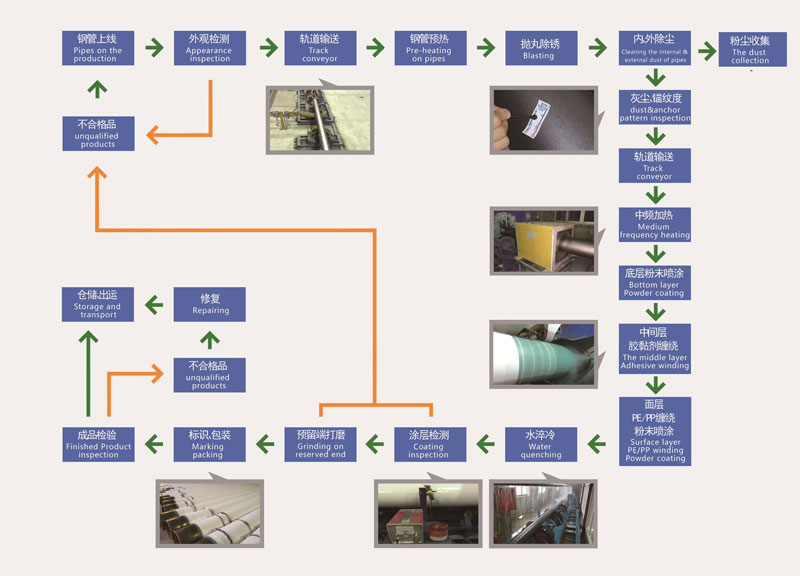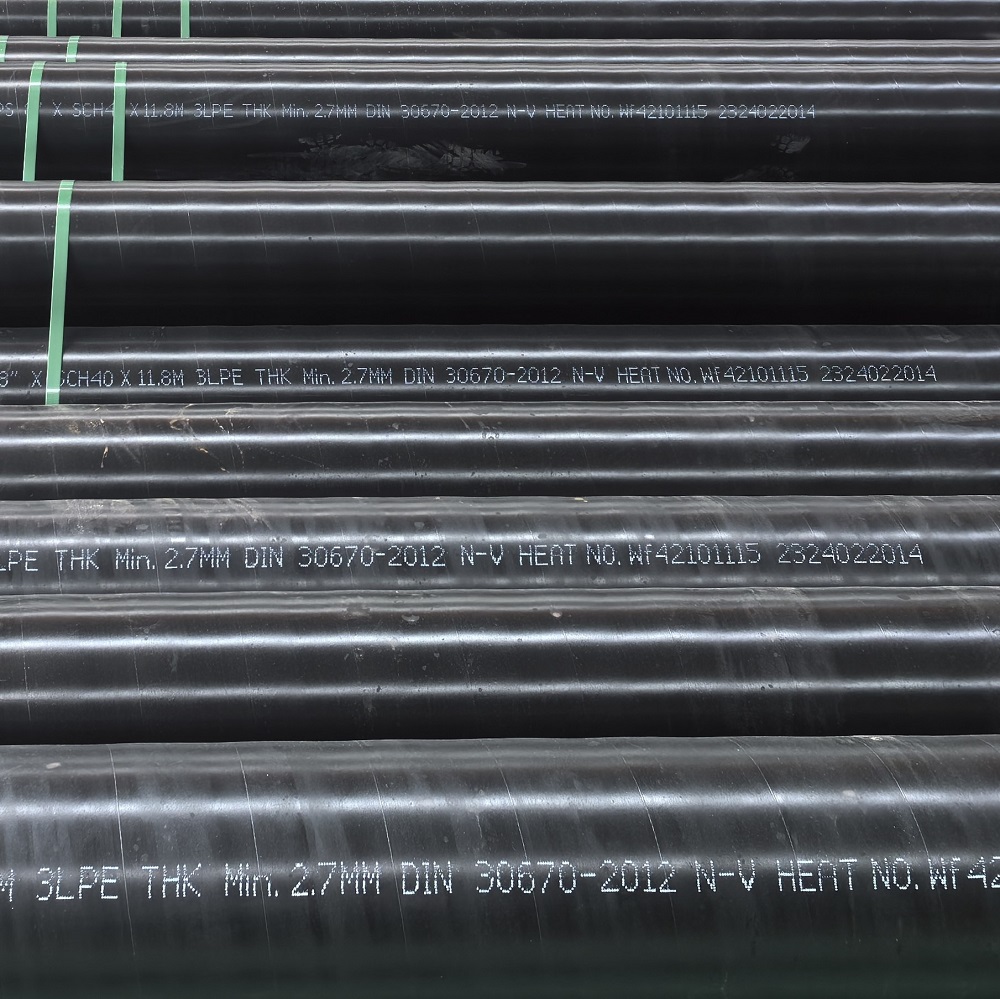ISO 21809-1 3-Layer Polyethylene (3LPE) Coated Line Pipe
- Applied Steel Service Pipe: API 5L/ISO 3183 Gr.B-X100, ASTM A53/A106 Gr.B, ASTM A333 Gr.1/3/6, ASTM A671/A672/A691
ISO 21809-1 3-Layer Polyethylene (3LPE) Coated Line Pipe
Our ISO 21809-1 3-layer polyethylene (3LPE) coated line pipe is designed to meet the demanding requirements of the international standard ISO 21809-1 for coatings for pipes and fittings for pipelines in petroleum and natural gas industries. The 3LPE coating consists of three layers: an inner layer of fusion bonded epoxy, a middle layer of adhesive, and an outer layer of polyethylene. This unique three-layer structure provides excellent protection against corrosion, abrasion, and chemical damage, making it an ideal solution for harsh environments. Our 3LPE coated line pipe is resistant to cracks, punctures, and tears, ensuring the integrity of the pipeline system. It is also suitable for use in a wide range of temperatures, from -40°C to 80°C (-40°F to 176°F), making it an excellent choice for applications in extreme environments. Our ISO 21809-1 3LPE coated line pipe is widely used in the transportation of oil, gas, and petrochemical products, as well as in offshore platforms and land-based infrastructure projects. With its excellent performance characteristics, our 3LPE coated line pipe ensures reliable operation, reduced maintenance costs, and extended lifespan of the pipeline system.
Specifications
| Standard | ISO 21809-1 3-Layer Polyethylene (3LPE) Coated Line Pipe |
| Applied Steel Service Pipe | API 5L/ISO 3183 Gr.B-X100, ASTM A53/A106 Gr.B, ASTM A333 Gr.1/3/6, ASTM A671/A672/A691 |
| Processing ability | OD:38mm-1620mm; WT:2mm-30mm |
| Length | 6-18m |
| Surface Preparation | ISO 8501-1/SIS 055900/DIN 55928 Sa 2.5/NACE No.2/SPCC SP10 (Near White Metal Finish) |
| Coating Structure | First Layer: Epoxy Primer Layer; Second Layer: Adhesive Layer; Third Layer: High-density Polyethylene Layer |
| Packing | 1. Both ends of the pipe are beveled to 30°+5°/-0° according to ASME B16.25. 2. For large-diameter pipes (OD≥NPS 8″), each pipe is equipped with 3 anti-collision ropes (3 locations) and 2 slings, with plastic covers at the ends of the pipes, or reusable metal bevel protectors (with sealing cloth), loosely packed. 3. For small-diameter pipes (OD≤NPS 6″), each pipe is equipped with 3 anti-collision ropes (3 locations), plastic covers at the ends of the pipes, and 2 slings per bundle (the whole bundle can be wrapped in a woven bag according to the coating type or customer requirements) and tied with plastic strips (woven bags are placed underneath to protect the coating from scratches) |
| Technique | Coated on Seamless/ERW/HFW/LSAW/SSAW/JCOE/UOE/RBE Line Pipes |
| Service condition | Design working temperature ranges: -40℃ to +80℃; alkaline or sour service |
| Place of Origin | Made in China |
| MOQ | Depends on order quantity |
| Transportation | Railway, By Sea |
Coating Classes and Design Temperature Ranges
| Coating Class | Top Layer Material | -40°C | -20°C | 0°C | +20°C | +40°C | +60°C | +80°C | +100°C | +120°C |
| A | LDPE | X | X | X | X | |||||
| B | MDPE, HDPE | X | X | X | X | X | X | |||
| C* | PP | X | X | X | X | X | ||||
| * Installation and transportation at temperatures below 0°C can cause mechanical damage. | ||||||||||
Minimum Total Coating Thickness
| Class A1 | Class A2 | Class A3 | Class B1 | Class B2 | Class B3 | Class C1 | Class C2 | Class C3 | |
| Pm≤15 | 1.8 | 2.1 | 2.6 | 1.3 | 1.8 | 2.3 | 1.3 | 1.7 | 2.1 |
| 15<Pm≤50 | 2.0 | 2.4 | 3.0 | 1.5 | 2.1 | 2.7 | 1.5 | 1.9 | 2.4 |
| 50<Pm≤130 | 2.4 | 2.8 | 3.5 | 1.8 | 2.5 | 3.1 | 1.8 | 2.3 | 2.8 |
| 130<Pm≤300 | 2.6 | 3.2 | 3.9 | 2.2 | 2.8 | 3.5 | 2.2 | 2.5 | 3.2 |
| Pm≤300 | 3.2 | 3.8 | 4.7 | 2.5 | 3.3 | 4.2 | 2.5 | 3.0 | 3.8 |
Coating Performance
| Essential characteristic | Performance | Technical specification | |||||||
| Total coating thickness | Pm | Unit | Values | ISO 21809-1:2018 | |||||
| Class A | Class B | ||||||||
| A1 | A2 | A3 | B1 | B2 | B3 | ||||
| Pm≤15 | Kg/m | 1.8 | 2.1 | 2.6 | 1.3 | 1.8 | 2.3 | ||
| 15<Pm≤50 | 2.0 | 2.4 | 3.0 | 1.5 | 2.1 | 2.7 | |||
| 50<Pm≤130 | 2.4 | 2.8 | 3.5 | 1.8 | 2.5 | 3.1 | |||
| 130<Pm≤300 | 2.6 | 3.2 | 3.9 | 2.2 | 2.8 | 3.5 | |||
| Pm>300 | 3.2 | 3.8 | 4.7 | 2.5 | 3.3 | 4.2 | |||
| Temperature | Unit | Cl.ass A | Class B | ||||||
| Strainin brake | at 23°C±3°C | % | 400 | 400 | |||||
| Stress at yield | at 23°C±3°C | MPa | 10,0 | 15,0 | |||||
| Continuity | – | – | Free of defects and discontinuities, delaminations, separations and holidays | ||||||
| Indentation | at 23°C±3°C | mm | ≤0,3 | ≤0,2 | |||||
| at maximum design temperature | ≤0,4 | ≤0,4 | |||||||
| Impact strength | at 23°C±3°C | J/mm | >5 | >7 | |||||
| Peel strength | at 23°C | N/mm | ≥10 | ≥18 | |||||
| at 60°C | ≥2.0 | – | |||||||
| at 80°C | – | ≥5.0 | |||||||
| △Tg | – | ℃ | -3,0℃≤△Tg≤+3,0°C | ||||||
| Product stability during appl. of the PE top layer process |
– | % | △MFR≤20 | ||||||
| Cathodic disbondment | at 23°C/28d; -1.38V | mm | ≤5,0 | ||||||
| at 65°C/28d; -1.38V | ≤4,0 | ||||||||
| Flexibility | – | Degrees per pipe length diameter | No cracking at an angle of 2,0° per pipe diameter length | ||||||
| Resistance to hot water | – | mm | Average≤2,0 and maximum≤3,0 | ||||||
| UV resistance | – | % | △MFR≤35 | △MFR≤35 | |||||
| Apparent density of PE coating | – | g/cm’ | ≥0.930 | ≥0.940 | |||||
3LPE Coating Production Process

Applications of ISO 21809-1 3-Layer Polyethylene (3LPE) Coated Line Pipe
ISO 21809-1 specifies requirements for three-layer polyethylene (3LPE) coated steel line pipes used for the transportation of liquids, gases, and other substances. These coatings provide excellent protection against corrosion and mechanical damage.
Oil and Gas Industry:
Transmission Pipelines: Transporting crude oil, natural gas, and refined petroleum products over long distances from production sites to refineries and distribution centers.
Subsea Pipelines: Underwater pipelines for offshore oil and gas exploration and production.
Distribution Networks: Delivery of gas and oil products to residential, commercial, and industrial users.
Water Supply Systems:
Potable Water Pipelines: Distribution of drinking water from treatment plants to consumers.
Irrigation Pipelines: Transporting water for agricultural purposes.
Industrial Applications:
Chemical and Petrochemical Plants: Conveyance of chemicals, petrochemicals, and other industrial fluids.
Slurry Pipelines: Transport of abrasive materials like mining slurries.
Infrastructure Projects:
Urban and Rural Infrastructure: Pipes used in municipal water supply and sewage systems.
Power Plants: Pipelines for cooling water and other utilities.
Marine and Coastal Environments:
Harbor and Dock Installations: Pipelines exposed to seawater and harsh coastal conditions.
Desalination Plants: Conveyance of seawater to and from desalination facilities.
Storage Facilities:
Tank Farms: Pipelines connecting storage tanks for various liquids and gases.




